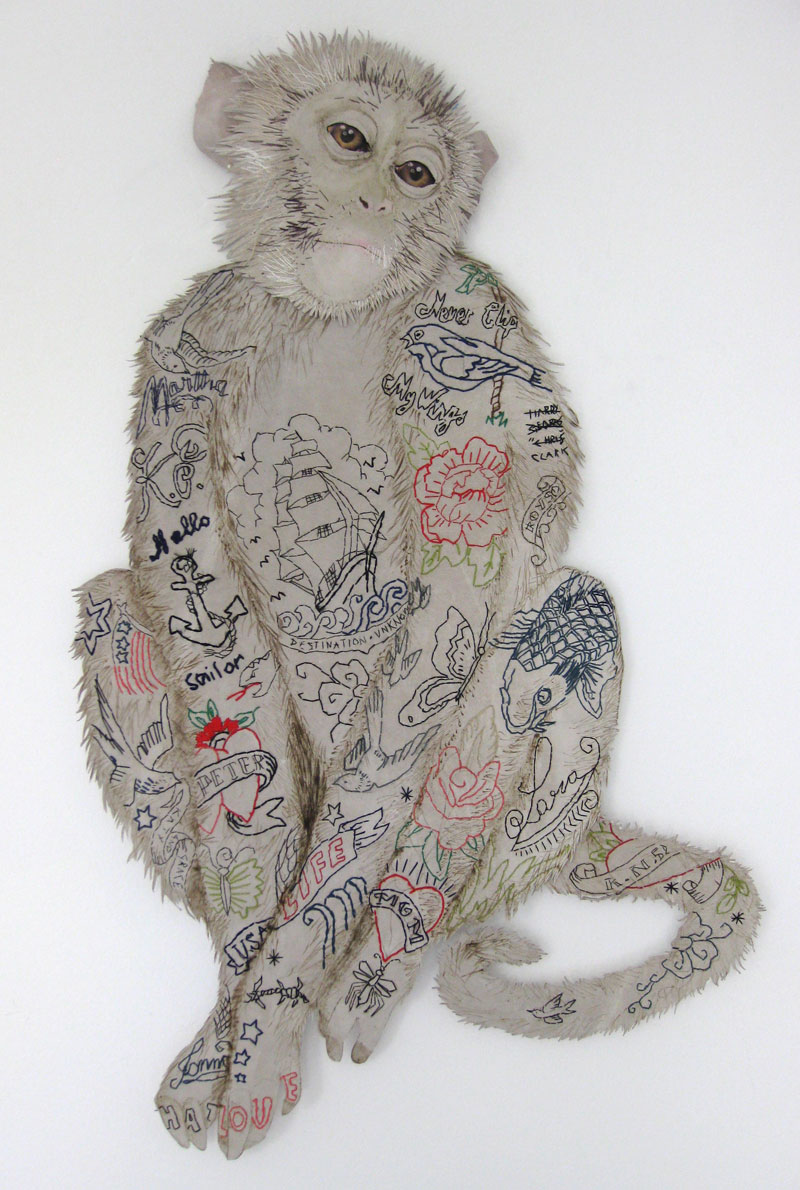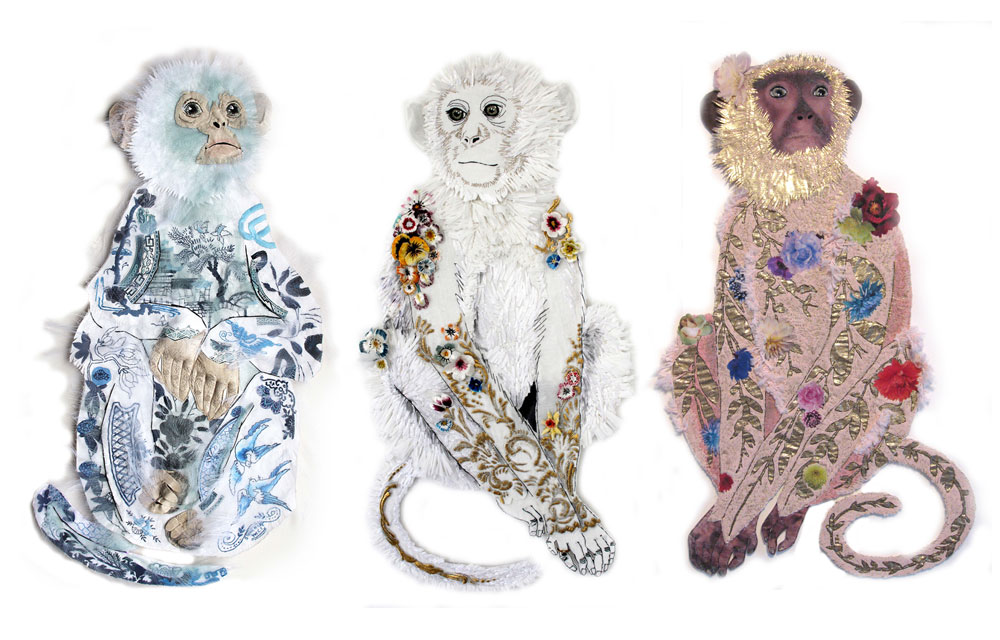Karen Nicol interview: The versatility of textiles

We were introduced to the brilliant work of embroiderer and mixed media textile artist Karen Nicol by Nigel Cheney, who referenced her as one of his major influences in the in-depth interview we carried out with him earlier this year.
Karen has a hugely diverse career and works in gallery, fashion and interiors with a London based design and production studio. She specialises in Irish, Cornelly, Multihead, beading and hand embroidery.
Here she tells us about an initial reluctance to become an embroiderer and how being a ‘magpie’ has informed and influenced her fascinating body of work.
A baptism of fire
TextileArtist.org: What was your route to becoming a mixed media textile artist?
Karen Nicol: My mother and sister were both embroiderers. My mother stitched and painted and demonstrated flower arranging and is a Master in Ikebana and my sister went to MMU and did a degree in Embroidery.
My mother taught us all the basics from square one; at the age of 14 she made us both a dress pattern block and said that she would buy us any fabric from the local market but no more clothes… a baptism of fire but brilliant. At that age you have no fear and I would blithely swan around town in dresses held together with a bit of sewing but also staples and tape and with large white swathes of fabric down the back because it was from the end of a roll of printing; this was the bit that had been sellotaped to the edge of the print table.
My father was a coal man but with the mind of an engineer; constantly designing and creating Heath Robinson contraptions with an innovative look at everything.
I desperately wanted to do something with more street cred than embroidery, aiming to be a fine artist, painter or sculptor, but I just couldn’t ignore the versatility and diversity of textiles as a medium.
I did a BA(Hons) specialising in embroidery at Manchester Metropolitan University and then an MA at the Royal College of Art.
Tell us about your chosen technique and how you apply this to your work?
I use all techniques and any materials, whatever suits what I am trying to say and everything used is with the utmost irreverence. I suppose my ‘chosen technique’ is loosely to push the manipulation of materials and stitch as far as I can.
I was fortunate enough to be taught all the traditional techniques from ‘aemilia ars’ to ‘trapunto’ and beyond and think they are all the most brilliant vocabulary to then explore, explode and develop.
My most used ‘tool’ is my Irish machine.
Embroidery with plastics and chiffon
Embroidered with peacock hurl
Embroidered with resin with images trapped under
Countless different projects at once
You work a lot in fashion and also interiors – what are the differences in approaching the work?
Designing embroidery commercially for fashion and interiors is quite focused on cost; the Holy Grail for both is to find a way of working that is quick to do but looks expensive, and I try to design things I can do the production of here rather than it going overseas. It’s useless creating a tiny time-consuming ornate embroidery cuff which you can’t see on a catwalk and prices the garment out of the market.
Another important consideration is that you must be flexible and versatile and enjoy the challenge of having to work in different styles and on countless different projects at once. I enjoy having to try to be constantly innovative.
Then of course in both fashion and interiors work practicality and cleaning have to be considerations, whereas with gallery work I can just do anything.
Couture creatures
How would you describe your work and where do you think it fits within the sphere of contemporary art?
I create ‘couture creatures’ I suppose. I use my animals to explore the the interesting dichotomy of man wearing animal skins and animals ‘clothed ‘ in skins inspired by human culture… I’m not sure where it fits in the sphere of contemporary art; I still think of myself as a designer more than a mixed media textile artist.
Tell us a bit about your process and what environment you like to work in?
I have a studio in my home in Hampton Court. My husband, artist Peter Clark, and I have taken over two floors for studios and showrooms. My studio is a really brilliant room with fantastic lighting and all my machines and materials and braids and beads etc to hand. I work quite long hours (although not nearly as long as I used to when I worked in fashion) and usually 7 days a week and I’m extremely happy doing it. My mind is plotting and planning something to do with work probably most of the time. We walk down to the Palace with the dog for a coffee a couple of times a day.
I also teach (I was senior lecturer on the mixed media course at the RCA for 15 years) and visit different art colleges to give lectures all of which I really love.
Process obviously changes with the different jobs. I like to draw and experiment with materials then tend to just jump in and start. The animals I tend to draw on tracing paper (so I have the reverse if I use bondaweb). Then I transfer the drawing to a big piece of fabric (the bears are usually about 2 metres tall and a monkey nearly a metre) and then just begin to work always trying to push the possibilities a bit by telling myself I can start again if it’s rubbish.
A magpie manner
What currently inspires you and which other artists do you admire and why?
The range of things which I find inspirational is enormous. I carry a notebook and camera everywhere with me and make images of everything that I see that I find visually stimulating in any way. This isn’t to inspire what I’m involved with at the time necessarily but for the future, so it’s limitless. It can be anything from a roughly painted gate to the seaming on a coat of someone sitting in front of me. I adore museums, art galleries, magazines, films, street style etc. I also have a passion (or a problem) with inspirational finds from car boot sales where I collect, again in a magpie manner, anything that inspires either in shape or quality or texture or technique (my book ‘Embellished: New Vintage’ covers all this side of things).
At the moment I’m looking at cut glass, I want to do a ‘monkey’ inspired by cut glass so its all about exploring embroidery on plastics maybe with transparent yarns.
I love the work of so many artists, again constantly changing; Doris Salcedo, Franz West, Liu Bolin at the moment and there are always constants like Dufy, Cy Twombly, Picasso and so many more.
Embroidered sculpture and wallpaper
How has your work developed since you began and how do you see it evolving in the future?
My work has changed direction many times as any freelance embroiderer who wants to earn a living from their work needs to stay focused on market trends and you are constantly learning. The more I do, the more ideas I have of what I can do. It is all still basically the same as it’s all based on drawing really. I have explored many materials and developed many ways of working that I haven’t seen before and so that is exciting. For my next show, I want to include embroidered sculpture, embroidered paper and wallpaper, but those ideas are still in my head.
Do people commission your work? If so, how do you go about meeting their requirements?
People do commission my work and we just talk through what they want and what I can do. I have huge archives of work and portfolios of different possibilities… it’s no different from taking on a fashion or interiors project. It’s an exciting collaboration where two minds can meet to create something which is beyond either individual.
How do you go about choosing where to show your work?
I show with the Rebecca Hossack Gallery in London W1. She has two galleries in London and one in New York where I had a show in November 2012.
The gallery also travels the world showing the work in art fairs. For instance, this year I have shown in Paris and London, Art 13 and the next fair opens soon in Hong Kong and then New York and Toronto.
Where can readers see your work this year?
I have a monkey show ‘A Grande Singerie’ which opens at the Rebecca Hossack Gallery in Charlotte Street London W1 on the 4th October 2013.
For more information please visit: www.karennicol.com
Let us know if you’ve enjoyed this article by leaving a comment below.
























What an amazing artiste – love the interview!
Hi there – thanks for the comment. Yes – Karen is certainly inspirational. Glad you enjoyed the interview. All the best, Joe.
Very inspirational thank you
Hi! I have been following Karen’s fabulous work for quite a while through “Selvedge” and some other publications – I love it! Thanks for this inspirational interview… : )
Animals are so inspirational within textile medium,and the techniques used to produce the fur and hair effect intrigues me as a student of Textile Art.
Lovely work Karen